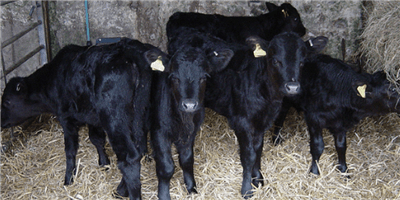Creep-feeding should be evaluated on yearly basis to determine if it will provide production and economic benefits to the operation. Nutrients required for calf growth are met through its dam milk and forage. Typically, adequate weight gain occurs with milk and grazed forage. However, as the amount of milk produced by the dam decreases, forage quality declines as it matures, and the calf gets older it becomes more difficult to meet the calf’s nutrient requires. Decreases in forage quality (energy and protein) or quantity creates insufficient nutrients for optimum gain. In these situations, creep-feeding may be a viable option. Additionally, first-calf heifers and older cows may not produce enough milk to support the desired calf performance, hence creep-feeding may be a benefit in these situations.
Creep-Feed Selection
Selecting the optimal creep-feed is important for the best economic benefit. The two most common types of creep feeds used in South Dakota are energy or protein creep feeds. The most common is high energy creep. Creep-feeds can be mixed on the farm/ranch or purchased.
The ration must be energy and protein dense, because the rumen of the calf is small, so the calf will not eat a large amount of feed. Additionally, the feeds must be palatable. Most commercially available creep rations are pelleted and highly palatable. Non-pelleted creep feeds must be dust-free and uniformly mixed to prevent calves from sorting ingredients. Additionally, if liquid feed ingredients are added make sure the creep feed will flow through the feeder.
Energy creep-feeds can be made up of on-farm grains, such as corn, oats, or barley (either whole, cracked or rolled). Table 1 provides some examples of common creep-feed rations. Free choice high starch feeds can cause digestive disturbances, so use caution when selecting feedstuffs. Calves consuming large quantities of starch in grain-based creep feeds may experience acidosis. Limiting creep intake can prevent acidosis. Delivering high starch creep feed daily allows producers to limit intake; however, this is a very labor-intensive option. Intake of creep feed can be limited by adding salt to the creep feed as an intake limiter.
Research has reported feed to gain with calves fed high energy creep feeds to be 8:1 (range 15:1 to 7:1). This means it takes 8 pounds of creep feed on a dry matter basis to gain one pound. Another way of looking at it is calves fed high energy creep feed typically gain 0.20 to 0.30 pound more per per day compared to non-creep fed calves.
Soybean meal, canola meal, dehydrated alfalfa pellets, or a commercial protein supplement without urea are all potential high protein creep feeds. Creep feed should not contain urea for young calves since they do not have a fully functional rumen. Commercially available, nutritionally balanced, creep-feeds in a pellet form can be more convenient to use and often will be of similar or lower cost to those made up on the farm.

Data suggests that the feed to gain conversion with high-protein creep feeds averages 4:1, which is better than the conversion with high-energy creep feeds. Additionally, calves normally consume less creep feed and gain less weight over the creep feeding period. Adequate supply of forage is important when using a high-protein creep feed.
Evaluating Economic Benefits
Although creep feeding can significantly increase weaning weight, costs associated with creep feeding can result in minimal economic benefit. Therefore, when evaluating the financial benefit of creep feeding, it is important to understand the relationship between the cost of the creep feed consumed and the value of the additional weight gained. Table 2 shows an example budget for calculating returns per head for creep feeding. In this example, it costs more to provide the creep feed than the value of the added weaning weight. Columns are provided below within table 2 for you to use to evaluate the returns from creep feeding in your situation.

###
Julie Walker – Professor & SDSU Extension Beef Specialist
iGrow – South Dakota State University Extension
Northern Ag Network


